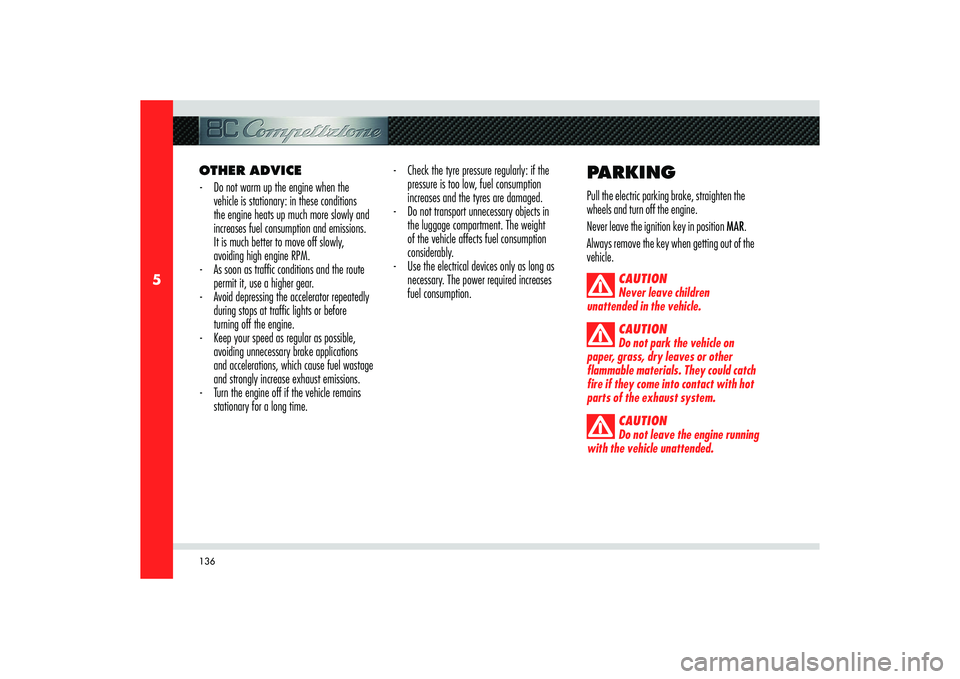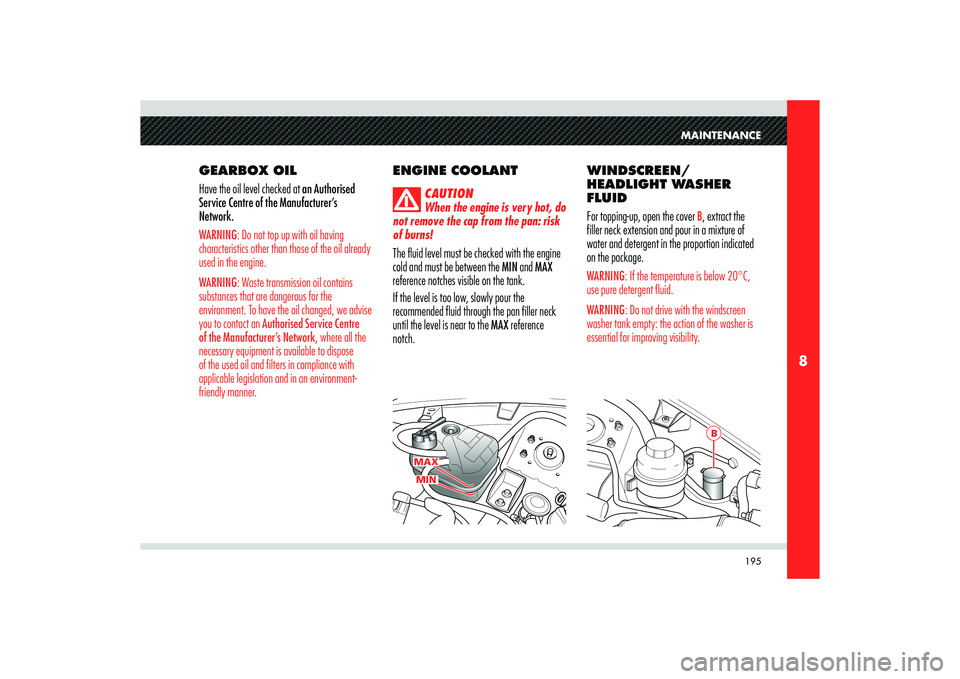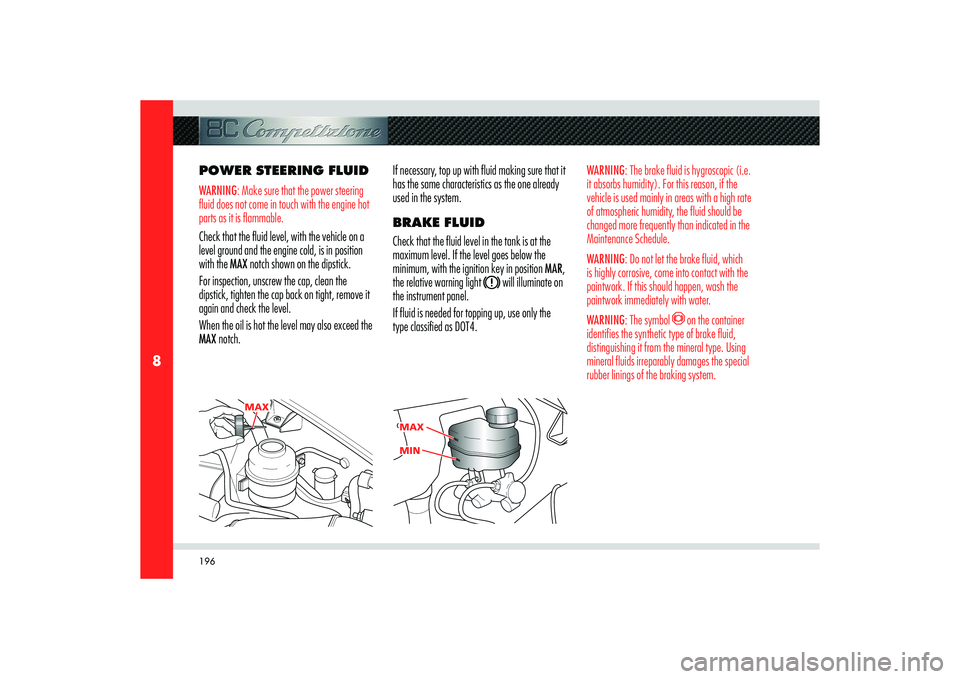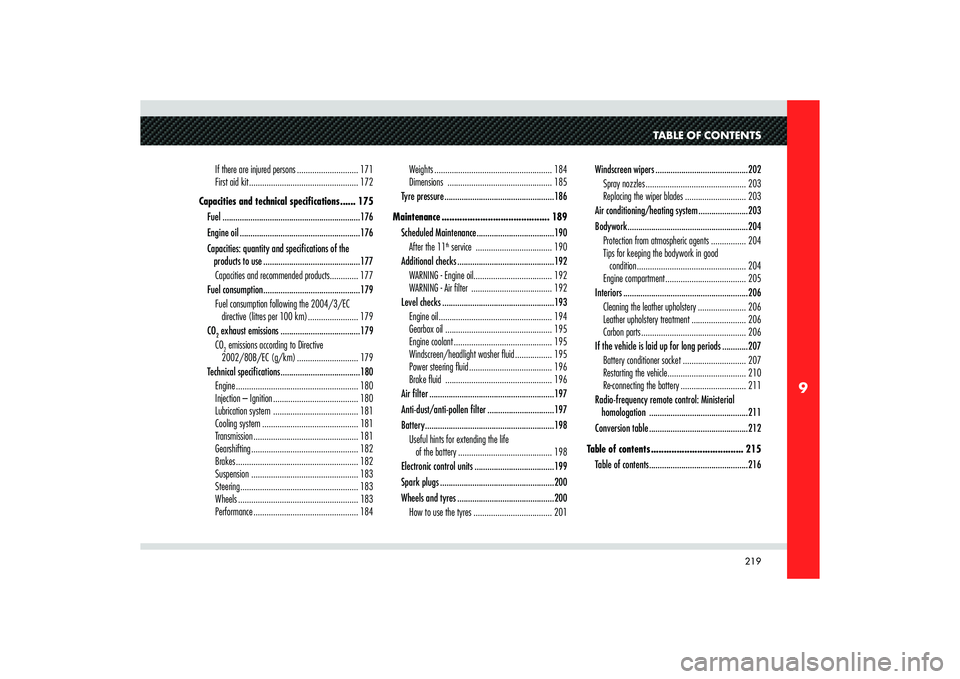check engine light Alfa Romeo 8C 2010 Owner handbook (in English)
[x] Cancel search | Manufacturer: ALFA ROMEO, Model Year: 2010, Model line: 8C, Model: Alfa Romeo 8C 2010Pages: 223, PDF Size: 14.35 MB
Page 138 of 223

136
5
OTHER ADVICE
- Do not warm up the engine when the
vehicle is stationary: in these conditions
the engine heats up much more slowly and
increases fuel consumption and emissions.
It is much better to move off slowly,
avoiding high engine RPM.
- As soon as traffi c conditions and the route
permit it, use a higher gear.
- Avoid depressing the accelerator repeatedly
during stops at traffi c lights or before
turning off the engine.
- Keep your speed as regular as possible,
avoiding unnecessary brake applications
and accelerations, which cause fuel wastage
and strongly increase exhaust emissions.
- Turn the engine off if the vehicle remains
stationary for a long time. - Check the tyre pressure regularly: if the
pressure is too low, fuel consumption
increases and the tyres are damaged.
- Do not transport unnecessary objects in
the luggage compartment. The weight
of the vehicle affects fuel consumption
considerably.
- Use the electrical devices only as long as
necessary. The power required increases
fuel consumption.
PARKINGPull the electric parking brake, straighten the
wheels and turn off the engine.
Never leave the ignition key in position MAR.
Always remove the key when getting out of the
vehicle.
CAUTION
Never leave children
unattended in the vehicle.
CAUTION
Do not park the vehicle on
paper, grass, dry leaves or other
flammable materials. They could catch
fire if they come into contact with hot
parts of the exhaust system.
CAUTION
Do not leave the engine running
with the vehicle unattended.
Page 140 of 223

138
5
B
Engagement
The electric parking brake is automatically
applied when the engine is turned off and the
vehicle is stationary.
It can only be disengaged when the engine is
restarted.
When the key is removed or set to STOP it
cannot be disengaged.
The electric parking brake can also be manually
engaged when the vehicle is moving or the key is
turned to MAR by pulling up the lever
B.
If the engine was turned off with the automatic
engagement device deactivated, you can
reactivated it simply by pulling lever B.
CAUTION
Always check that the vehicle is
actually locked before leaving it.
CAUTION
When the EPB button is
activated while driving, the vehicle
slows down with strong deceleration
(Dynamic Braking). It is therefore
advisable to use this function only
in case of an emergency. The vehicle
stability is in any case ensured by the
VDC system, which is always active.
Disengagement
The parking brake automatically disengages
when the accelerator pedal is depressed.
The electric parking brake can also be manually
disengaged when the vehicle is moving or the
key is in position MAR by manually pulling up
lever
B and simultaneously depressing the brake
pedal.
WARNING: In certain conditions it is however
advisable to manually disengage the electric
parking brake and brake the starting manoeuvre
slightly using the service brake. This is advisable
when there are obstacles very close to the
vehicle in the direction in which you intend to
move.
Page 141 of 223

139
5
A
USING THE VEHICLE
Malfunction indication
In the event of electric parking brake system
failures, the warning light
! on the display
will come on.
Depending on the message displayed, it signals
the following failures of the EPB system:
- Parking brake failure
If the message warning you to go to the
nearest Authorised Service Centre of the
Manufacturer’s Network is displayed,
drive slowly and remember that the electric
parking brake device is not functioning.
- Excessive temperature. If after leaving the engine off (key turned
to STOP) for about 15 minutes without
using the parking brake, the warning
light illuminates again when the engine
is started, slowly drive to an Authorised
Service Centre of the Manufacturer’s
Network. If the brake failure is accompanied by the
message “Mechanical release only”, the
manual emergency deactivation procedure
must be performed to release the parking
brake.
Deactivating the PARK OFF automatic
operation
To deactivate manual operation of the electric
parking brake, with the engine on, press the
button
A on the dashboard. The words PARK OFF
will appear on the display for 5 seconds and then
the page that was active previously will reappear.
To reactivate automatic operation, press the
button A again, the words PARK ON appear on
the display for 5 seconds.
WARNING: In certain conditions, when the
battery voltage is low, the electric parking brake
activation/deactivation system may temporarily
be deactivated for safety reasons. Therefore,
typically during engine starting when the battery
voltage drops, the message PARK OFF may
temporarily appear on the display indicating that
automatic operation is temporarily disabled.
WARNING: In the case of performance
starting, check that the electric parking brake is
disengaged.
Page 150 of 223

148
6
CD
E
F
Remove the cigarette lighter
C, and insert the
connector
D.
Start the engine by pressing the start button (see
page 114).
Press the Fix&Go button
E at position “I”. The
electric compressor will activate and the liquid
with air will inflate the tyre.
A pressure of at least 1.8 bar (26 psi) should
be reached within 20 minutes. If this does not
occur, turn off and remove the Fix&Go kit.
Move the vehicle forward and backward by 10
metres to better distribute the sealant in the tyre.Attach the quick-connector of the compressor
directly on the tyre valve and repeat the inflation
procedure.
If the minimum tyre pressure is not reached,
do not start the vehicle. Contact an Authorised
Service Centre of the Manufacturer’s
Network.
When the correct pressure has been reached,
move the vehicle forward and backward to
evenly distribute the sealant in the tyre.
After 10 minutes, stop and check the tyre
pressure. If the pressure is below 1.3 bar
(19 psi), do not drive the vehicle. The tyre is
excessively damaged. Contact an Authorised Service Centre of the
Manufacturer’s Network.
If the pressure is equal to or greater than 1.3
bar (19 psi), repeat the inflation procedure until
reaching the adequate tyre pressure and resume
driving.
Remove the warning label
F from the bottle and
position it on the dashboard as a reminder to
the driver that the tyre has been treated with
automatic Fix&Go.
Page 197 of 223

195
8
MAXMIN
B
MAINTENANCE
GEARBOX OIL
Have the oil level checked at an Authorised
Service Centre of the Manufacturer’s
Network.WARNING: Do not top up with oil having
characteristics other than those of the oil already
used in the engine.
WARNING: Waste transmission oil contains
substances that are dangerous for the
environment. To have the oil changed, we advise
you to contact an Authorised Service Centre
of the Manufacturer’s Network, where all the
necessary equipment is available to dispose
of the used oil and filters in compliance with
applicable legislation and in an environment-
friendly manner.
ENGINE COOLANT
CAUTION
When the engine is very hot, do
not remove the cap from the pan: risk
of burns!
The fluid level must be checked with the engine
cold and must be between the MIN and MAX
reference notches visible on the tank.
If the level is too low, slowly pour the
recommended fluid through the pan filler neck
until the level is near to the MAX reference
notch.WINDSCREEN/
HEADLIGHT WASHER
FLUID
For topping-up, open the cover
B, extract the
filler neck extension and pour in a mixture of
water and detergent in the proportion indicated
on the package.
WARNING: If the temperature is below 20°C,
use pure detergent fluid.
WARNING: Do not drive with the windscreen
washer tank empty: the action of the washer is
essential for improving visibility.
Page 198 of 223

196
8
MAX
MA
X MAX
MIN MIN
POWER STEERING FLUIDWARNING: Make sure that the power steering
fluid does not come in touch with the engine hot
parts as it is flammable.Check that the fluid level, with the vehicle on a
level ground and the engine cold, is in position
with the MAX notch shown on the dipstick.
For inspection, unscrew the cap, clean the
dipstick, tighten the cap back on tight, remove it
again and check the level.
When the oil is hot the level may also exceed the
MAX notch.If necessary, top up with fluid making sure that it
has the same characteristics as the one already
used in the system.
BRAKE FLUID
Check that the fluid level in the tank is at the
maximum level. If the level goes below the
minimum, with the ignition key in position MAR,
the relative warning light
will illuminate on
the instrument panel.
If fluid is needed for topping up, use only the
type classified as DOT4.
WARNING: The brake fluid is hygroscopic (i.e.
it absorbs humidity). For this reason, if the
vehicle is used mainly in areas with a high rate
of atmospheric humidity, the fluid should be
changed more frequently than indicated in the
Maintenance Schedule.
WARNING: Do not let the brake fluid, which
is highly corrosive, come into contact with the
paintwork. If this should happen, wash the
paintwork immediately with water.
WARNING: The symbol
on the container
identifies the synthetic type of brake fluid,
distinguishing it from the mineral type. Using
mineral fluids irreparably damages the special
rubber linings of the braking system.
Page 200 of 223

198
8
A
B
C
BATTERYThe battery is of the “low maintenance” type,
and is located on the right side of the luggage
compartment
To access the battery lift the shelf and
A and the
box cover
B releasing the hooks.
C.
With the vehicle standing on a flat surface, the
battery fluid level (electrolyte) must be between
the MIN and MAX reference notches shown on
the battery.
If the level is lower than the MIN reference
notch, contact an Authorised Service Centre
of the Manufacturer’s Network to have it
checked.To recharge the battery, see the section “In an
emergency”.
CAUTION
The fluid contained in the
battery is poisonous and corrosive.
Avoid contact with the skin and eyes.
Do not approach the battery with open
flames or possible sources of sparks:
risk of explosion and fire!
Batteries contain substances that are very
harmful for the environment. We advise you
to have the battery replaced at an Authorised
Service Centre of the Manufacturer’s
Network, where all the necessary equipment
is available to dispose of the used parts in compliance with applicable legislation and in an
environment-friendly manner.
WARNING: Incorrect assembly of electrical and
electronic accessories can cause serious damage
to the vehicle.USEFUL HINTS FOR
EXTENDING THE LIFE OF
THE BATTERY
When parking the vehicle, make sure that the
doors, luggage and engine compartment lids
are properly closed. All interior lights should be
off. When the engine is off, do not keep the
connected devices switched on for a long time
(for example the radio, the hazard warning
lights, the fan, etc.).
Page 221 of 223

219
9
TABLE OF CONTENTS
If there are injured persons ............................ 171
First aid kit .................................................. 172
Capacities and technical specifi cations ...... 175
Fuel ................................................................176
Engine oil ........................................................176
Capacities: quantity and speci� cations of the
products to use .............................................177
Capacities and recommended products ............. 177
Fuel consumption .............................................179
Fuel consumption following the 2004/3/EC
directive (litres per 100 km) ....................... 179
CO2 exhaust emissions .....................................179
CO2 emissions according to Directive
2002/80B/EC (g/km) ............................ 179
Technical speci� cations .....................................180
Engine ........................................................ 180
Injection – Ignition ....................................... 180
Lubrication system ....................................... 181
Cooling system ............................................ 181
Transmission ................................................ 181
Gearshifting ................................................. 182
Brakes ........................................................ 182
Suspension ................................................. 183
Steering ...................................................... 183
Wheels ....................................................... 183
Performance ................................................ 184Weights ...................................................... 184
Dimensions ................................................ 185
Tyre pressure ...................................................186
Maintenance .......................................... 189
Scheduled Maintenance ....................................190
After the 11
th service ................................... 190
Additional checks .............................................192
WARNING - Engine oil .................................... 192
WARNING - Air fi lter ..................................... 192
Level checks ....................................................193
Engine oil .................................................... 194
Gearbox oil ................................................. 195
Engine coolant ............................................. 195
Windscreen/headlight washer fl uid ................. 195
Power steering fl uid ...................................... 196
Brake fl uid ................................................. 196
Air � lter ..........................................................197
Anti-dust/anti-pollen � lter ...............................197
Battery ............................................................198
Useful hints for extending the life
of the battery ........................................... 198
Electronic control units .....................................199
Spark plugs .....................................................200
Wheels and tyres .............................................200
How to use the tyres .................................... 201Windscreen wipers ...........................................202
Spray nozzles .............................................. 203
Replacing the wiper blades ............................ 203
Air conditioning/heating system .......................203
Bodywork ........................................................204
Protection from atmospheric agents ................ 204
Tips for keeping the bodywork in good
condition .................................................. 204
Engine compartment ..................................... 205
Interiors ..........................................................206
Cleaning the leather upholstery ...................... 206
Leather upholstery treatment ......................... 206
Carbon parts ................................................ 206
If the vehicle is laid up for long periods ............207
Battery conditioner socket ............................. 207
Restarting the vehicle .................................... 210
Re-connecting the battery .............................. 211
Radio-frequency remote control: Ministerial
homologation ..............................................211
Conversion table ..............................................212
Table of contents .................................... 215
Table of contents ..............................................216